Assessment of the Prevalence of Depression Among Post Stroke Patients
VerifiedAdded on 2022/09/01
|11
|2683
|16
Thesis and Dissertation
AI Summary
This thesis investigates the prevalence of post-stroke depression (PSD) among patients in rural Malaysia receiving primary care. The study aims to assess PSD prevalence, identify associated factors, and explore the relationship between PSD and adverse outcomes. The research includes assessment tools like the Beck's Depression Inventory, the National Institutes of Health Stroke Scale, and the Modified Ranking Scale. The study highlights the significance of addressing PSD in rural settings, where healthcare access may be limited, and aims to provide insights for improving assessment, treatment, and management protocols. The thesis is structured to cover the introduction, methodology, results, discussion, future recommendations, and conclusion, offering a comprehensive analysis of PSD in this specific context. The research questions focus on the prevalence of PSD, associated factors, and the link between adverse outcomes and depression severity, providing a robust framework for understanding and addressing this critical mental health issue. The findings of this thesis are significant since these will pave the way for identification of the key factors contributing to the prevalence of PSD in rural Malaysian post stroke patients.
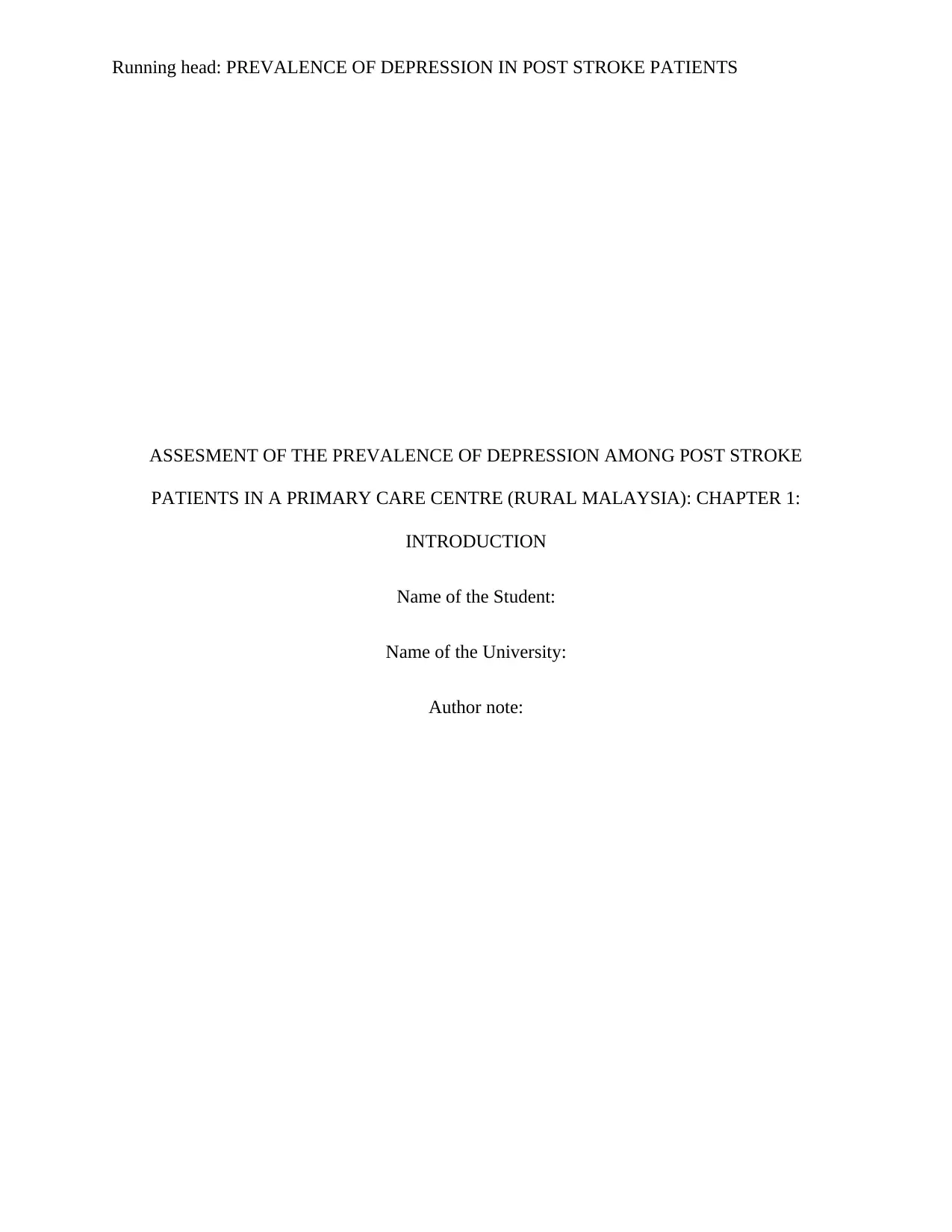
Running head: PREVALENCE OF DEPRESSION IN POST STROKE PATIENTS
ASSESMENT OF THE PREVALENCE OF DEPRESSION AMONG POST STROKE
PATIENTS IN A PRIMARY CARE CENTRE (RURAL MALAYSIA): CHAPTER 1:
INTRODUCTION
Name of the Student:
Name of the University:
Author note:
ASSESMENT OF THE PREVALENCE OF DEPRESSION AMONG POST STROKE
PATIENTS IN A PRIMARY CARE CENTRE (RURAL MALAYSIA): CHAPTER 1:
INTRODUCTION
Name of the Student:
Name of the University:
Author note:
Paraphrase This Document
Need a fresh take? Get an instant paraphrase of this document with our AI Paraphraser
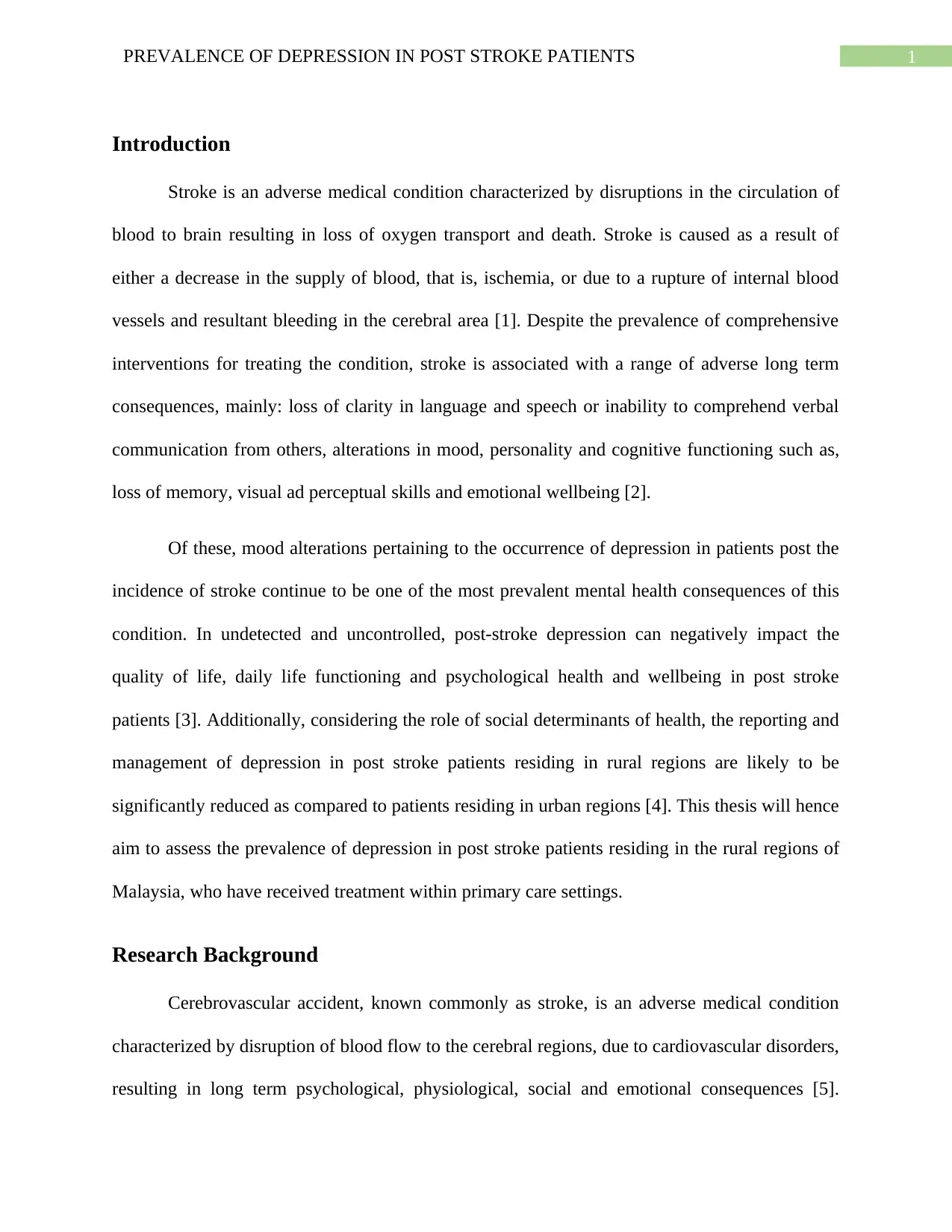
1PREVALENCE OF DEPRESSION IN POST STROKE PATIENTS
Introduction
Stroke is an adverse medical condition characterized by disruptions in the circulation of
blood to brain resulting in loss of oxygen transport and death. Stroke is caused as a result of
either a decrease in the supply of blood, that is, ischemia, or due to a rupture of internal blood
vessels and resultant bleeding in the cerebral area [1]. Despite the prevalence of comprehensive
interventions for treating the condition, stroke is associated with a range of adverse long term
consequences, mainly: loss of clarity in language and speech or inability to comprehend verbal
communication from others, alterations in mood, personality and cognitive functioning such as,
loss of memory, visual ad perceptual skills and emotional wellbeing [2].
Of these, mood alterations pertaining to the occurrence of depression in patients post the
incidence of stroke continue to be one of the most prevalent mental health consequences of this
condition. In undetected and uncontrolled, post-stroke depression can negatively impact the
quality of life, daily life functioning and psychological health and wellbeing in post stroke
patients [3]. Additionally, considering the role of social determinants of health, the reporting and
management of depression in post stroke patients residing in rural regions are likely to be
significantly reduced as compared to patients residing in urban regions [4]. This thesis will hence
aim to assess the prevalence of depression in post stroke patients residing in the rural regions of
Malaysia, who have received treatment within primary care settings.
Research Background
Cerebrovascular accident, known commonly as stroke, is an adverse medical condition
characterized by disruption of blood flow to the cerebral regions, due to cardiovascular disorders,
resulting in long term psychological, physiological, social and emotional consequences [5].
Introduction
Stroke is an adverse medical condition characterized by disruptions in the circulation of
blood to brain resulting in loss of oxygen transport and death. Stroke is caused as a result of
either a decrease in the supply of blood, that is, ischemia, or due to a rupture of internal blood
vessels and resultant bleeding in the cerebral area [1]. Despite the prevalence of comprehensive
interventions for treating the condition, stroke is associated with a range of adverse long term
consequences, mainly: loss of clarity in language and speech or inability to comprehend verbal
communication from others, alterations in mood, personality and cognitive functioning such as,
loss of memory, visual ad perceptual skills and emotional wellbeing [2].
Of these, mood alterations pertaining to the occurrence of depression in patients post the
incidence of stroke continue to be one of the most prevalent mental health consequences of this
condition. In undetected and uncontrolled, post-stroke depression can negatively impact the
quality of life, daily life functioning and psychological health and wellbeing in post stroke
patients [3]. Additionally, considering the role of social determinants of health, the reporting and
management of depression in post stroke patients residing in rural regions are likely to be
significantly reduced as compared to patients residing in urban regions [4]. This thesis will hence
aim to assess the prevalence of depression in post stroke patients residing in the rural regions of
Malaysia, who have received treatment within primary care settings.
Research Background
Cerebrovascular accident, known commonly as stroke, is an adverse medical condition
characterized by disruption of blood flow to the cerebral regions, due to cardiovascular disorders,
resulting in long term psychological, physiological, social and emotional consequences [5].

2PREVALENCE OF DEPRESSION IN POST STROKE PATIENTS
According to the World Health Organization, stroke is the second highest contributor of
mortality on a global scale and one of the third highest contributor of disabilities across the
global population. Stroke is caused due to a decrease in the flow of blood to the brain as a result
of a ruptured or blocked artery in the cerebral region, resulting in hypoxic condition and atrophy
of brain cells. For this reason, it is not surprising to find a high prevalence of mental and
cognitive dysfunction in patients post the incidence of stroke, in the form of depression and
dementia [6]. Indeed, as evidenced by the American Heart Association (AHA), one out of three
individuals who have encountered stroke, have experienced depression along with higher rates of
mortality and inadequate functional outcomes. Despite being a prevalent consequence after
stroke, post stroke depression (PSD) has been evidenced to be one of the underreported and
undiagnosed conditions in stroke patients with limited information concerning its assessment,
screening, prevention and treatment [7]. Thus, considering the same, the following thesis will
emphasize on the implications of the incidence, epidemiology, causative factors and
consequences of PSD after stroke in clinical practice by drawing on the prevalence of PSD
among post stroke patients admitted in primary care settings and residing in the rural regions of
Malaysia.
Research Rationale
According to the Diagnostic and Statistical Manual of Mental Disorders (DSM V), PSD
is the name given to a disorder in mood which has been superimposed in an individual following
the episode of another medical illness, that is, a stroke and is accompanied with symptoms
pertaining to mania, depression or mixed clinical outcomes [8]. Depression is a common adverse
consequence of stroke with a high rate of prevalence as compared to other medical conditions
with similar levels of disability. Post stroke individuals are given a diagnosis of stroke based on
According to the World Health Organization, stroke is the second highest contributor of
mortality on a global scale and one of the third highest contributor of disabilities across the
global population. Stroke is caused due to a decrease in the flow of blood to the brain as a result
of a ruptured or blocked artery in the cerebral region, resulting in hypoxic condition and atrophy
of brain cells. For this reason, it is not surprising to find a high prevalence of mental and
cognitive dysfunction in patients post the incidence of stroke, in the form of depression and
dementia [6]. Indeed, as evidenced by the American Heart Association (AHA), one out of three
individuals who have encountered stroke, have experienced depression along with higher rates of
mortality and inadequate functional outcomes. Despite being a prevalent consequence after
stroke, post stroke depression (PSD) has been evidenced to be one of the underreported and
undiagnosed conditions in stroke patients with limited information concerning its assessment,
screening, prevention and treatment [7]. Thus, considering the same, the following thesis will
emphasize on the implications of the incidence, epidemiology, causative factors and
consequences of PSD after stroke in clinical practice by drawing on the prevalence of PSD
among post stroke patients admitted in primary care settings and residing in the rural regions of
Malaysia.
Research Rationale
According to the Diagnostic and Statistical Manual of Mental Disorders (DSM V), PSD
is the name given to a disorder in mood which has been superimposed in an individual following
the episode of another medical illness, that is, a stroke and is accompanied with symptoms
pertaining to mania, depression or mixed clinical outcomes [8]. Depression is a common adverse
consequence of stroke with a high rate of prevalence as compared to other medical conditions
with similar levels of disability. Post stroke individuals are given a diagnosis of stroke based on
⊘ This is a preview!⊘
Do you want full access?
Subscribe today to unlock all pages.

Trusted by 1+ million students worldwide

3PREVALENCE OF DEPRESSION IN POST STROKE PATIENTS
symptoms postulated by the DSM V Criteria, that is, the prevalence of loss of pleasure in
previously desirable activities, along with other symptoms, for a duration of a minimum of two
weeks. However, the abnormal cognitive, somatic and visual-perceptual alterations associated
with stroke make it difficult for health professionals to correctly present a specific diagnosis of
PSD within post stroke patients [9]. Additionally, there continues to remain speculations
concerning the true pathologies of PSD with multiple etiological mechanisms being reported by
a number of studies. One such mechanism which has been postulated is the assumption that
depression is the product of neural damage induced by the cerebrovascular effects of stroke, or
even due to possible reduction of monoamines [10]. Thus, the existing dearth of findings
concerning pathological underlying the incidence of PSD form the rationale for this thesis’s
exploration of PSD prevalence and associated independent factors in PSD patients.
Additionally, there is an absence of a standardized assessment and screening tool
specializing solely in measuring the presence of PSD in post stroke patients. In addition to the
DSM criteria, a range of assessment tools have been evidenced to be used in healthcare settings,
most of which have varied rating scales and scores for cut offs and focus primarily on severity
assessment and not diagnosis of PSD in post stroke patients. Such methodological and
assessment complications may be a key contributor of high rates of underreporting and
misdiagnosis of PSD [11]. The lack of adequate assessments for PSD thus form an additional
rationale for this thesis’s exploration of PSD prevalence and associated independent factors in
PSD patients.
If left untreated, PSD is regarded to be the worst factor of prognosis and significant
predictor of the quality of life in post stroke patients. Additionally, unmitigated PSD can raise
several additional complications in post stroke patients such as suicide ideation, reduced
symptoms postulated by the DSM V Criteria, that is, the prevalence of loss of pleasure in
previously desirable activities, along with other symptoms, for a duration of a minimum of two
weeks. However, the abnormal cognitive, somatic and visual-perceptual alterations associated
with stroke make it difficult for health professionals to correctly present a specific diagnosis of
PSD within post stroke patients [9]. Additionally, there continues to remain speculations
concerning the true pathologies of PSD with multiple etiological mechanisms being reported by
a number of studies. One such mechanism which has been postulated is the assumption that
depression is the product of neural damage induced by the cerebrovascular effects of stroke, or
even due to possible reduction of monoamines [10]. Thus, the existing dearth of findings
concerning pathological underlying the incidence of PSD form the rationale for this thesis’s
exploration of PSD prevalence and associated independent factors in PSD patients.
Additionally, there is an absence of a standardized assessment and screening tool
specializing solely in measuring the presence of PSD in post stroke patients. In addition to the
DSM criteria, a range of assessment tools have been evidenced to be used in healthcare settings,
most of which have varied rating scales and scores for cut offs and focus primarily on severity
assessment and not diagnosis of PSD in post stroke patients. Such methodological and
assessment complications may be a key contributor of high rates of underreporting and
misdiagnosis of PSD [11]. The lack of adequate assessments for PSD thus form an additional
rationale for this thesis’s exploration of PSD prevalence and associated independent factors in
PSD patients.
If left untreated, PSD is regarded to be the worst factor of prognosis and significant
predictor of the quality of life in post stroke patients. Additionally, unmitigated PSD can raise
several additional complications in post stroke patients such as suicide ideation, reduced
Paraphrase This Document
Need a fresh take? Get an instant paraphrase of this document with our AI Paraphraser
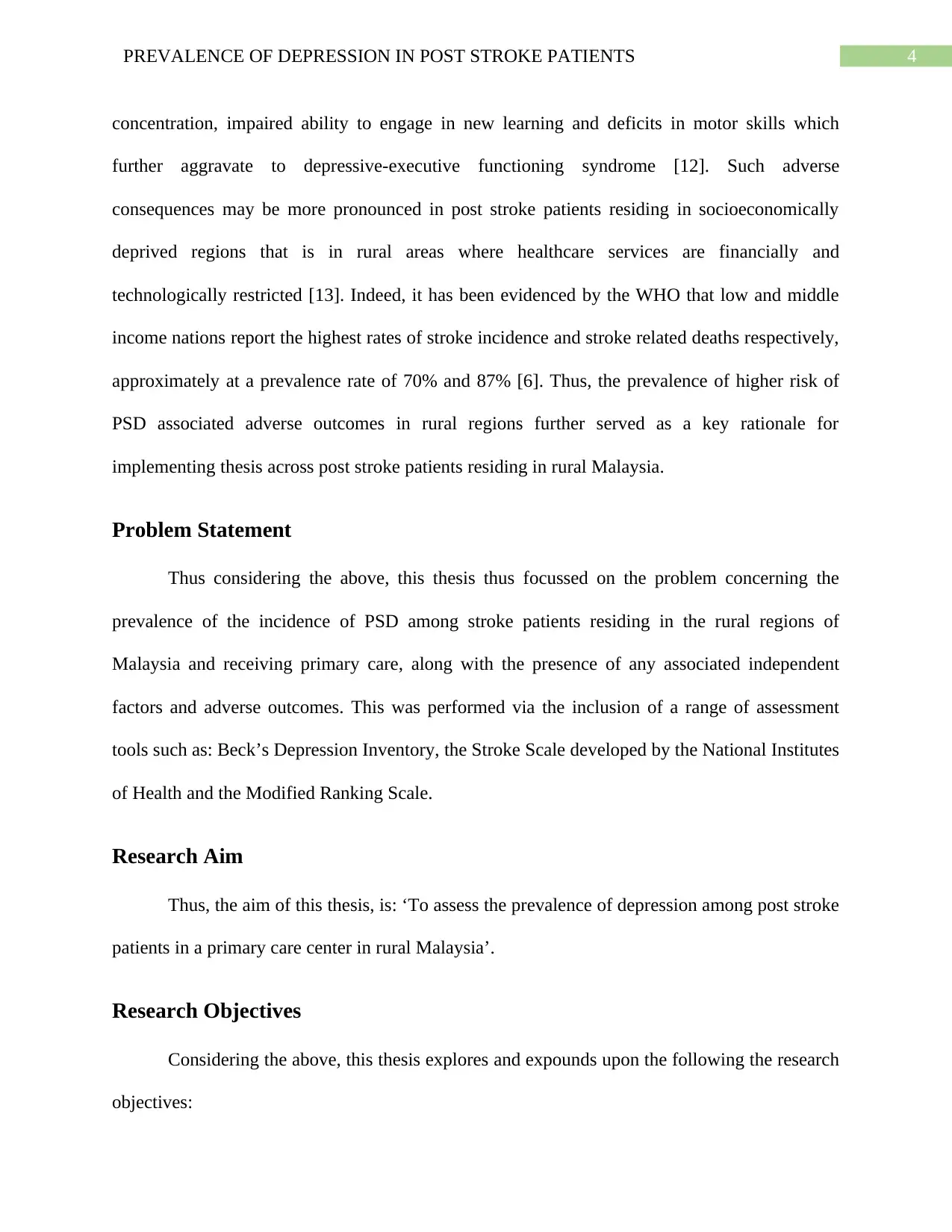
4PREVALENCE OF DEPRESSION IN POST STROKE PATIENTS
concentration, impaired ability to engage in new learning and deficits in motor skills which
further aggravate to depressive-executive functioning syndrome [12]. Such adverse
consequences may be more pronounced in post stroke patients residing in socioeconomically
deprived regions that is in rural areas where healthcare services are financially and
technologically restricted [13]. Indeed, it has been evidenced by the WHO that low and middle
income nations report the highest rates of stroke incidence and stroke related deaths respectively,
approximately at a prevalence rate of 70% and 87% [6]. Thus, the prevalence of higher risk of
PSD associated adverse outcomes in rural regions further served as a key rationale for
implementing thesis across post stroke patients residing in rural Malaysia.
Problem Statement
Thus considering the above, this thesis thus focussed on the problem concerning the
prevalence of the incidence of PSD among stroke patients residing in the rural regions of
Malaysia and receiving primary care, along with the presence of any associated independent
factors and adverse outcomes. This was performed via the inclusion of a range of assessment
tools such as: Beck’s Depression Inventory, the Stroke Scale developed by the National Institutes
of Health and the Modified Ranking Scale.
Research Aim
Thus, the aim of this thesis, is: ‘To assess the prevalence of depression among post stroke
patients in a primary care center in rural Malaysia’.
Research Objectives
Considering the above, this thesis explores and expounds upon the following the research
objectives:
concentration, impaired ability to engage in new learning and deficits in motor skills which
further aggravate to depressive-executive functioning syndrome [12]. Such adverse
consequences may be more pronounced in post stroke patients residing in socioeconomically
deprived regions that is in rural areas where healthcare services are financially and
technologically restricted [13]. Indeed, it has been evidenced by the WHO that low and middle
income nations report the highest rates of stroke incidence and stroke related deaths respectively,
approximately at a prevalence rate of 70% and 87% [6]. Thus, the prevalence of higher risk of
PSD associated adverse outcomes in rural regions further served as a key rationale for
implementing thesis across post stroke patients residing in rural Malaysia.
Problem Statement
Thus considering the above, this thesis thus focussed on the problem concerning the
prevalence of the incidence of PSD among stroke patients residing in the rural regions of
Malaysia and receiving primary care, along with the presence of any associated independent
factors and adverse outcomes. This was performed via the inclusion of a range of assessment
tools such as: Beck’s Depression Inventory, the Stroke Scale developed by the National Institutes
of Health and the Modified Ranking Scale.
Research Aim
Thus, the aim of this thesis, is: ‘To assess the prevalence of depression among post stroke
patients in a primary care center in rural Malaysia’.
Research Objectives
Considering the above, this thesis explores and expounds upon the following the research
objectives:
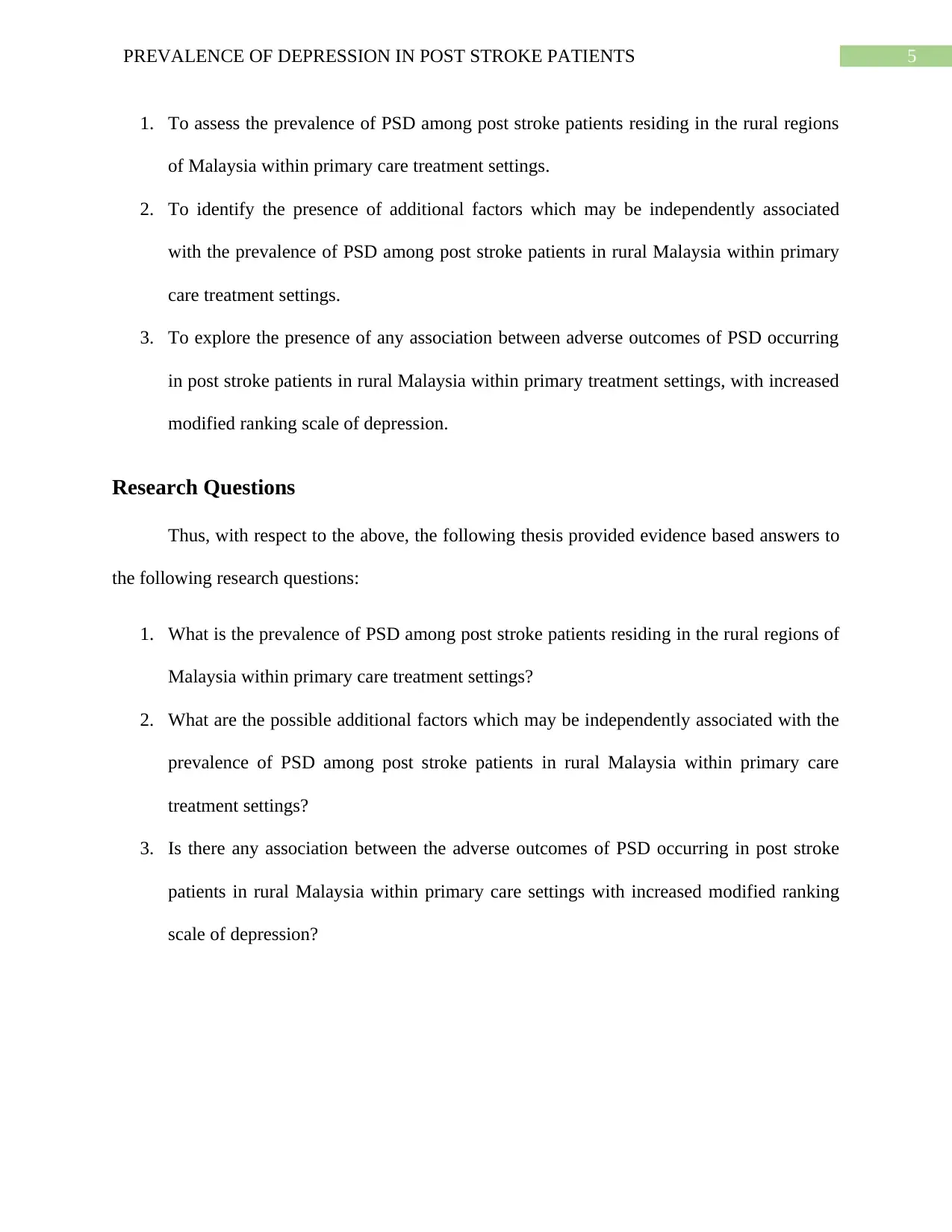
5PREVALENCE OF DEPRESSION IN POST STROKE PATIENTS
1. To assess the prevalence of PSD among post stroke patients residing in the rural regions
of Malaysia within primary care treatment settings.
2. To identify the presence of additional factors which may be independently associated
with the prevalence of PSD among post stroke patients in rural Malaysia within primary
care treatment settings.
3. To explore the presence of any association between adverse outcomes of PSD occurring
in post stroke patients in rural Malaysia within primary treatment settings, with increased
modified ranking scale of depression.
Research Questions
Thus, with respect to the above, the following thesis provided evidence based answers to
the following research questions:
1. What is the prevalence of PSD among post stroke patients residing in the rural regions of
Malaysia within primary care treatment settings?
2. What are the possible additional factors which may be independently associated with the
prevalence of PSD among post stroke patients in rural Malaysia within primary care
treatment settings?
3. Is there any association between the adverse outcomes of PSD occurring in post stroke
patients in rural Malaysia within primary care settings with increased modified ranking
scale of depression?
1. To assess the prevalence of PSD among post stroke patients residing in the rural regions
of Malaysia within primary care treatment settings.
2. To identify the presence of additional factors which may be independently associated
with the prevalence of PSD among post stroke patients in rural Malaysia within primary
care treatment settings.
3. To explore the presence of any association between adverse outcomes of PSD occurring
in post stroke patients in rural Malaysia within primary treatment settings, with increased
modified ranking scale of depression.
Research Questions
Thus, with respect to the above, the following thesis provided evidence based answers to
the following research questions:
1. What is the prevalence of PSD among post stroke patients residing in the rural regions of
Malaysia within primary care treatment settings?
2. What are the possible additional factors which may be independently associated with the
prevalence of PSD among post stroke patients in rural Malaysia within primary care
treatment settings?
3. Is there any association between the adverse outcomes of PSD occurring in post stroke
patients in rural Malaysia within primary care settings with increased modified ranking
scale of depression?
⊘ This is a preview!⊘
Do you want full access?
Subscribe today to unlock all pages.

Trusted by 1+ million students worldwide
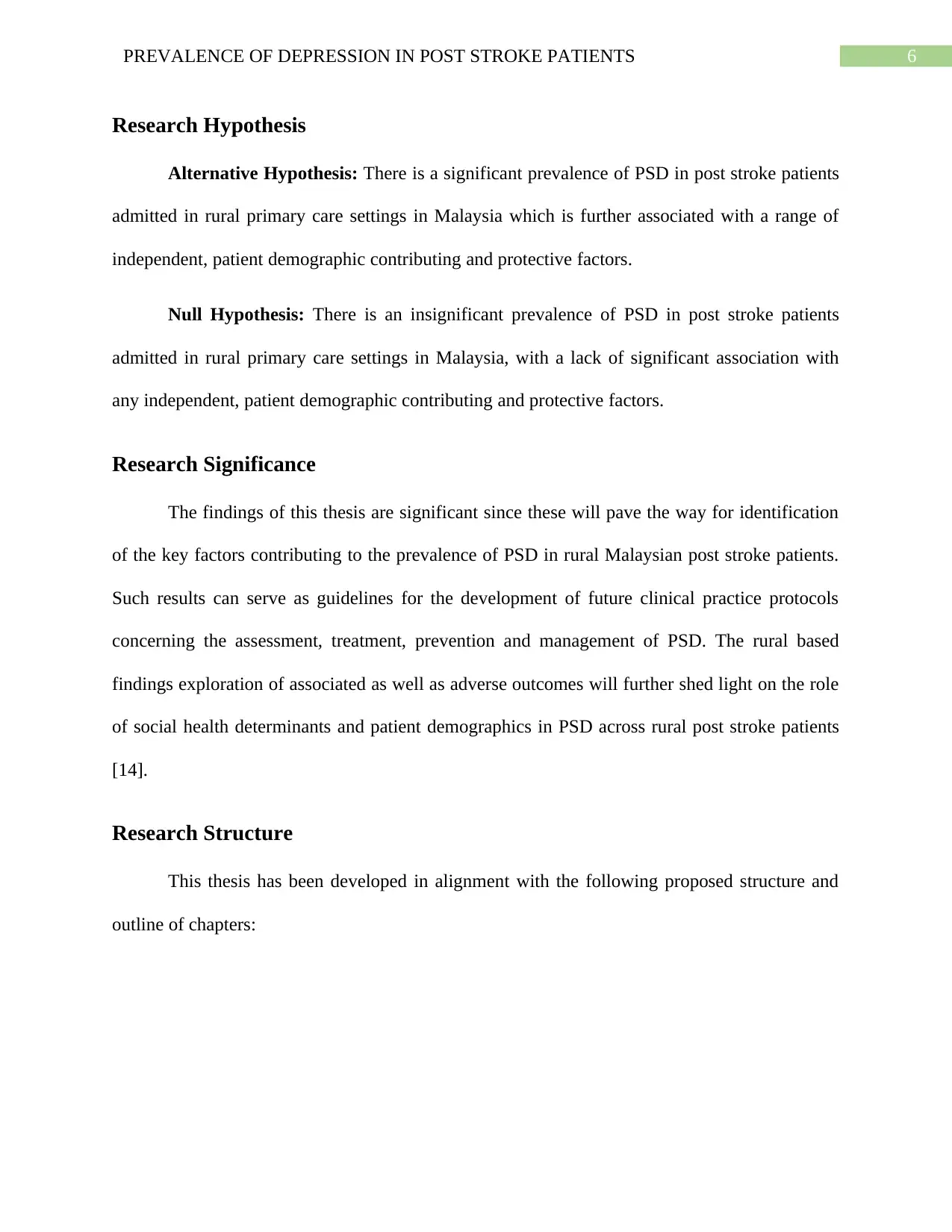
6PREVALENCE OF DEPRESSION IN POST STROKE PATIENTS
Research Hypothesis
Alternative Hypothesis: There is a significant prevalence of PSD in post stroke patients
admitted in rural primary care settings in Malaysia which is further associated with a range of
independent, patient demographic contributing and protective factors.
Null Hypothesis: There is an insignificant prevalence of PSD in post stroke patients
admitted in rural primary care settings in Malaysia, with a lack of significant association with
any independent, patient demographic contributing and protective factors.
Research Significance
The findings of this thesis are significant since these will pave the way for identification
of the key factors contributing to the prevalence of PSD in rural Malaysian post stroke patients.
Such results can serve as guidelines for the development of future clinical practice protocols
concerning the assessment, treatment, prevention and management of PSD. The rural based
findings exploration of associated as well as adverse outcomes will further shed light on the role
of social health determinants and patient demographics in PSD across rural post stroke patients
[14].
Research Structure
This thesis has been developed in alignment with the following proposed structure and
outline of chapters:
Research Hypothesis
Alternative Hypothesis: There is a significant prevalence of PSD in post stroke patients
admitted in rural primary care settings in Malaysia which is further associated with a range of
independent, patient demographic contributing and protective factors.
Null Hypothesis: There is an insignificant prevalence of PSD in post stroke patients
admitted in rural primary care settings in Malaysia, with a lack of significant association with
any independent, patient demographic contributing and protective factors.
Research Significance
The findings of this thesis are significant since these will pave the way for identification
of the key factors contributing to the prevalence of PSD in rural Malaysian post stroke patients.
Such results can serve as guidelines for the development of future clinical practice protocols
concerning the assessment, treatment, prevention and management of PSD. The rural based
findings exploration of associated as well as adverse outcomes will further shed light on the role
of social health determinants and patient demographics in PSD across rural post stroke patients
[14].
Research Structure
This thesis has been developed in alignment with the following proposed structure and
outline of chapters:
Paraphrase This Document
Need a fresh take? Get an instant paraphrase of this document with our AI Paraphraser
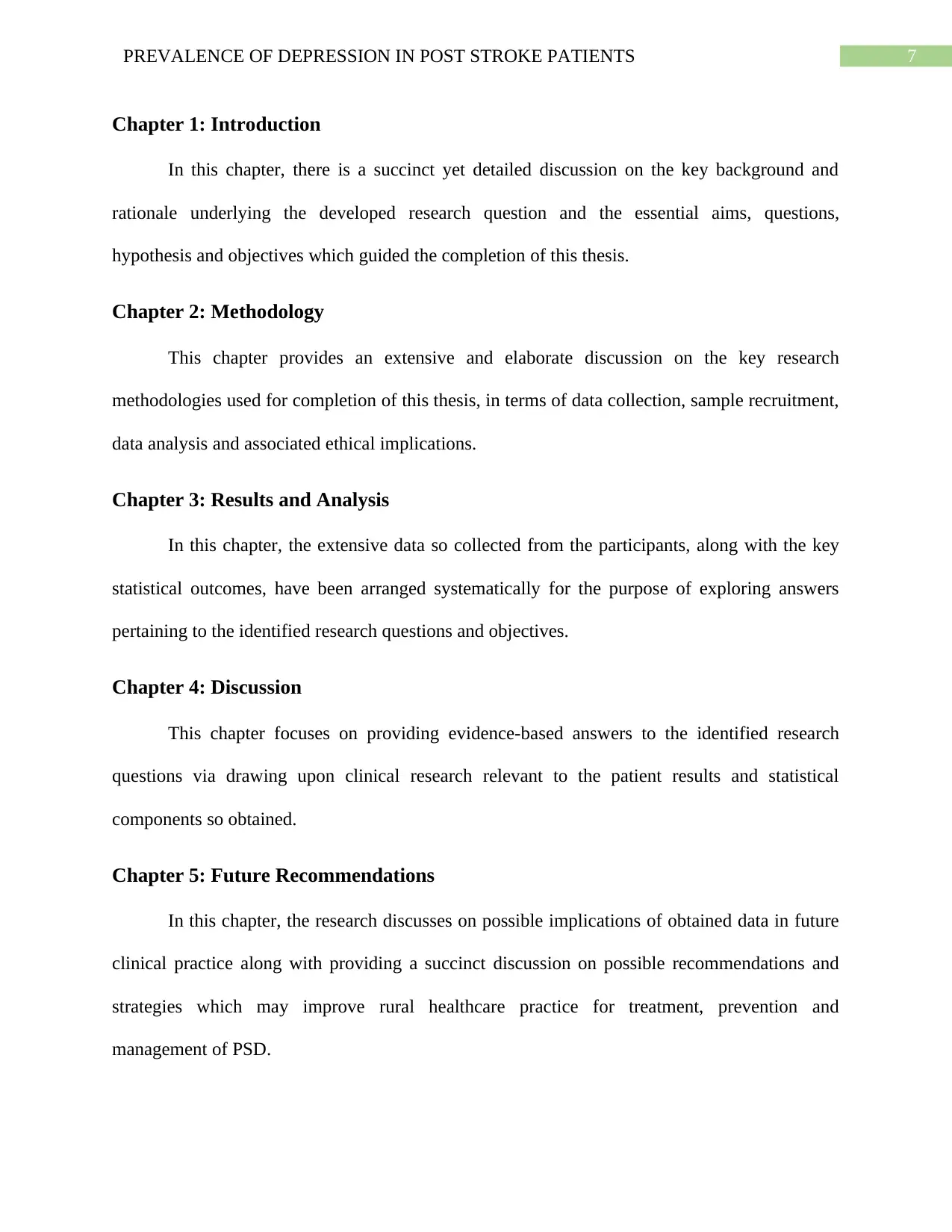
7PREVALENCE OF DEPRESSION IN POST STROKE PATIENTS
Chapter 1: Introduction
In this chapter, there is a succinct yet detailed discussion on the key background and
rationale underlying the developed research question and the essential aims, questions,
hypothesis and objectives which guided the completion of this thesis.
Chapter 2: Methodology
This chapter provides an extensive and elaborate discussion on the key research
methodologies used for completion of this thesis, in terms of data collection, sample recruitment,
data analysis and associated ethical implications.
Chapter 3: Results and Analysis
In this chapter, the extensive data so collected from the participants, along with the key
statistical outcomes, have been arranged systematically for the purpose of exploring answers
pertaining to the identified research questions and objectives.
Chapter 4: Discussion
This chapter focuses on providing evidence-based answers to the identified research
questions via drawing upon clinical research relevant to the patient results and statistical
components so obtained.
Chapter 5: Future Recommendations
In this chapter, the research discusses on possible implications of obtained data in future
clinical practice along with providing a succinct discussion on possible recommendations and
strategies which may improve rural healthcare practice for treatment, prevention and
management of PSD.
Chapter 1: Introduction
In this chapter, there is a succinct yet detailed discussion on the key background and
rationale underlying the developed research question and the essential aims, questions,
hypothesis and objectives which guided the completion of this thesis.
Chapter 2: Methodology
This chapter provides an extensive and elaborate discussion on the key research
methodologies used for completion of this thesis, in terms of data collection, sample recruitment,
data analysis and associated ethical implications.
Chapter 3: Results and Analysis
In this chapter, the extensive data so collected from the participants, along with the key
statistical outcomes, have been arranged systematically for the purpose of exploring answers
pertaining to the identified research questions and objectives.
Chapter 4: Discussion
This chapter focuses on providing evidence-based answers to the identified research
questions via drawing upon clinical research relevant to the patient results and statistical
components so obtained.
Chapter 5: Future Recommendations
In this chapter, the research discusses on possible implications of obtained data in future
clinical practice along with providing a succinct discussion on possible recommendations and
strategies which may improve rural healthcare practice for treatment, prevention and
management of PSD.

8PREVALENCE OF DEPRESSION IN POST STROKE PATIENTS
Chapter 6: Conclusion
The final chapter provides an overall summary of all the relevant data, evidence based
findings and future recommendation explored by the thesis, regarding the prevalence of PSD
across post stroke patients within primary care settings of rural Malaysia.
Conclusion
Thus, this chapter successfully discusses the relevant research background, rationale and
significance which assisted in development of the identified research question and associated key
components of this thesis. This chapter also provided a brief outlook into the major aims,
objectives, research questions and hypothesis based upon which, this thesis was completed, as
will be expounded upon in the succeeding sections. In conclusion, the relevance of this chapter
lies in its ability to set the scene of the overall thesis as well as the key outcomes which the
reader is expected to encounter upon complete examination of this study.
Chapter 6: Conclusion
The final chapter provides an overall summary of all the relevant data, evidence based
findings and future recommendation explored by the thesis, regarding the prevalence of PSD
across post stroke patients within primary care settings of rural Malaysia.
Conclusion
Thus, this chapter successfully discusses the relevant research background, rationale and
significance which assisted in development of the identified research question and associated key
components of this thesis. This chapter also provided a brief outlook into the major aims,
objectives, research questions and hypothesis based upon which, this thesis was completed, as
will be expounded upon in the succeeding sections. In conclusion, the relevance of this chapter
lies in its ability to set the scene of the overall thesis as well as the key outcomes which the
reader is expected to encounter upon complete examination of this study.
⊘ This is a preview!⊘
Do you want full access?
Subscribe today to unlock all pages.

Trusted by 1+ million students worldwide

9PREVALENCE OF DEPRESSION IN POST STROKE PATIENTS
References
1. de Man-van Ginkel JM, Hafsteindottir TB, Lindeman E, Geerlings M, Grobbee D,
Schuurmans MJ. Clinical manifestation of depression after stroke: different from
depression in other patients?. Journal of Advanced Nursing. 2016;72(S1):53-.
2. Hörnsten C, Lövheim H, Nordström P, Gustafson Y. The prevalence of stroke and
depression and factors associated with depression in elderly people with and without
stroke. BMC geriatrics. 2016 Dec;16(1):174.
3. Tarawneh R, Cummings JL. Depression, Psychosis, and Agitation in Stroke. InPrimer on
Cerebrovascular Diseases 2017 Jan 1 (pp. 767-774). Academic Press.
4. van Dijk MJ, de Man-van Ginkel JM, Hafsteinsdóttir TB, Schuurmans MJ. Identifying
depression post-stroke in patients with aphasia: a systematic review of the reliability,
validity and feasibility of available instruments. Clinical rehabilitation. 2016
Aug;30(8):795-810.
5. Fayed N, Morales H, Torres C, Viguera L. Neuroimaging of Post-stroke Depression.
InPsychiatry and Neuroscience Update 2019 (pp. 379-386). Springer, Cham.
6. Johnson W, Onuma O, Owolabi M, Sachdev S. Stroke: a global response is needed.
Bulletin of the World Health Organization. 2016 Sep 1;94(9):634.
7. Towfighi A, Ovbiagele B, El Husseini N, Hackett ML, Jorge RE, Kissela BM, Mitchell
PH, Skolarus LE, Whooley MA, Williams LS. Poststroke depression: a scientific
statement for healthcare professionals from the American Heart Association/American
Stroke Association. Stroke. 2017 Feb;48(2):e30-43.
References
1. de Man-van Ginkel JM, Hafsteindottir TB, Lindeman E, Geerlings M, Grobbee D,
Schuurmans MJ. Clinical manifestation of depression after stroke: different from
depression in other patients?. Journal of Advanced Nursing. 2016;72(S1):53-.
2. Hörnsten C, Lövheim H, Nordström P, Gustafson Y. The prevalence of stroke and
depression and factors associated with depression in elderly people with and without
stroke. BMC geriatrics. 2016 Dec;16(1):174.
3. Tarawneh R, Cummings JL. Depression, Psychosis, and Agitation in Stroke. InPrimer on
Cerebrovascular Diseases 2017 Jan 1 (pp. 767-774). Academic Press.
4. van Dijk MJ, de Man-van Ginkel JM, Hafsteinsdóttir TB, Schuurmans MJ. Identifying
depression post-stroke in patients with aphasia: a systematic review of the reliability,
validity and feasibility of available instruments. Clinical rehabilitation. 2016
Aug;30(8):795-810.
5. Fayed N, Morales H, Torres C, Viguera L. Neuroimaging of Post-stroke Depression.
InPsychiatry and Neuroscience Update 2019 (pp. 379-386). Springer, Cham.
6. Johnson W, Onuma O, Owolabi M, Sachdev S. Stroke: a global response is needed.
Bulletin of the World Health Organization. 2016 Sep 1;94(9):634.
7. Towfighi A, Ovbiagele B, El Husseini N, Hackett ML, Jorge RE, Kissela BM, Mitchell
PH, Skolarus LE, Whooley MA, Williams LS. Poststroke depression: a scientific
statement for healthcare professionals from the American Heart Association/American
Stroke Association. Stroke. 2017 Feb;48(2):e30-43.
Paraphrase This Document
Need a fresh take? Get an instant paraphrase of this document with our AI Paraphraser

10PREVALENCE OF DEPRESSION IN POST STROKE PATIENTS
8. Anderson CS. Depression After Stroke—Frequency, Risk Factors, and Mortality
Outcomes. JAMA psychiatry. 2016 Oct 1;73(10):1013-4.
9. Razmara A, Valle N, Markovic D, Sanossian N, Ovbiagele B, Dutta T, Towfighi A.
Depression is associated with a higher risk of death among stroke survivors. Journal of
Stroke and Cerebrovascular Diseases. 2017 Dec 1;26(12):2870-9.
10. Dar SK, Venigalla H, Khan AM, Ahmed R, Mekala HM, Zain H, Shagufta S. Post stroke
depression frequently overlooked, undiagnosed, untreated. Neuropsychiatry.
2017;7(6):906-19.
11. Laures-Gore JS, Farina M, Moore E, Russell S. Stress and depression scales in aphasia:
relation between the aphasia depression rating scale, stroke aphasia depression
questionnaire-10, and the perceived stress scale. Topics in stroke rehabilitation. 2017 Feb
17;24(2):114-8.
12. Villa RF, Ferrari F, Moretti A. Post-stroke depression: Mechanisms and pharmacological
treatment. Pharmacology & therapeutics. 2018 Apr 1;184:131-44.
13. Islam MA, Rahman A, Aleem MA, Islam SM. Prevalence and associated factors of
depression among post-stroke patients in Bangladesh. International journal of mental
health and addiction. 2016 Apr 1;14(2):154-66.
14. Chandran P, Shenoy D, Thavody J, Lilabi MP. Assessment of quality of life of stroke
survivors in a rural area of North Kerala, India. International Journal Of Community
Medicine And Public Health. 2017 Feb 22;4(3):841-6.
8. Anderson CS. Depression After Stroke—Frequency, Risk Factors, and Mortality
Outcomes. JAMA psychiatry. 2016 Oct 1;73(10):1013-4.
9. Razmara A, Valle N, Markovic D, Sanossian N, Ovbiagele B, Dutta T, Towfighi A.
Depression is associated with a higher risk of death among stroke survivors. Journal of
Stroke and Cerebrovascular Diseases. 2017 Dec 1;26(12):2870-9.
10. Dar SK, Venigalla H, Khan AM, Ahmed R, Mekala HM, Zain H, Shagufta S. Post stroke
depression frequently overlooked, undiagnosed, untreated. Neuropsychiatry.
2017;7(6):906-19.
11. Laures-Gore JS, Farina M, Moore E, Russell S. Stress and depression scales in aphasia:
relation between the aphasia depression rating scale, stroke aphasia depression
questionnaire-10, and the perceived stress scale. Topics in stroke rehabilitation. 2017 Feb
17;24(2):114-8.
12. Villa RF, Ferrari F, Moretti A. Post-stroke depression: Mechanisms and pharmacological
treatment. Pharmacology & therapeutics. 2018 Apr 1;184:131-44.
13. Islam MA, Rahman A, Aleem MA, Islam SM. Prevalence and associated factors of
depression among post-stroke patients in Bangladesh. International journal of mental
health and addiction. 2016 Apr 1;14(2):154-66.
14. Chandran P, Shenoy D, Thavody J, Lilabi MP. Assessment of quality of life of stroke
survivors in a rural area of North Kerala, India. International Journal Of Community
Medicine And Public Health. 2017 Feb 22;4(3):841-6.
1 out of 11
Related Documents
Your All-in-One AI-Powered Toolkit for Academic Success.
+13062052269
info@desklib.com
Available 24*7 on WhatsApp / Email
![[object Object]](/_next/static/media/star-bottom.7253800d.svg)
Unlock your academic potential
Copyright © 2020–2025 A2Z Services. All Rights Reserved. Developed and managed by ZUCOL.




